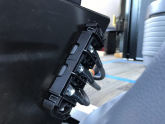A bunch of good questions.
Your inverter can probably peak out at a lot more than the 2200 watt (as an example, the 2000W Victron can surge 3000W). So, if the rest of the components can't supply that you are in danger of frying them. However, since you don't need the higher wattage, you may be able to get away with sizing your other components smaller and using a smaller breaker. I say breaker because with what we are talking about the likelyhood of it popping is higher due to human error (Doing more than planed). You want to be able to reset it.
> maximum load on it at any one time would be about 1800 watts for 5 minutes, once per day.
5 minutes is a long time in electron years. You should consider this steady state for your system sizing. Consequently the BMS will need to handle something greater than 150 amps. (170A would cover the load plus inverter loss). However, do you know if there is any turn-on surge associated with this load. As an example, when you first turn on a 1500W hair dryer, the heating elements are cold and actually present a much lower resistance. Therefore, it will draw a very high current for a few moments when you first turn it on. In most system, this would not even be noticed by the fuse and wiring. However, a good BMS is monitoring the current and will detect the over-current almost instantly. You say the BMS can handle a 200W peak, but the turn on surge might be much higher. The BMS might see the turn-on surge as a short and instantly shut off.
Now comes the real ugly part.
@Will Prowse is recommending we don't run the BMS at it's full rating. I have been thinking running at 80% rating would work nicely but in a recent video
@Will Prowse recommended a 50-60% number!
That makes if very difficult to find a good 12 volt BMS with all the features you want and can handle the current. I am struggling with this very problem right now and will probably end up putting a breaker on my inverter that will pop before the inverter reaches it's full surge potential.
Even then, I am using two banks of cells in parallel, each with its own 120A BMS.
There has been a lot of chater recently about using the BMS to control the inverter and not running the current through the BMS. (Check out Will's latest video on it.) The situation you are in with the boat probably means that is not a complete solution for you because you are going to have several loads and charge sources that you must shut off.




